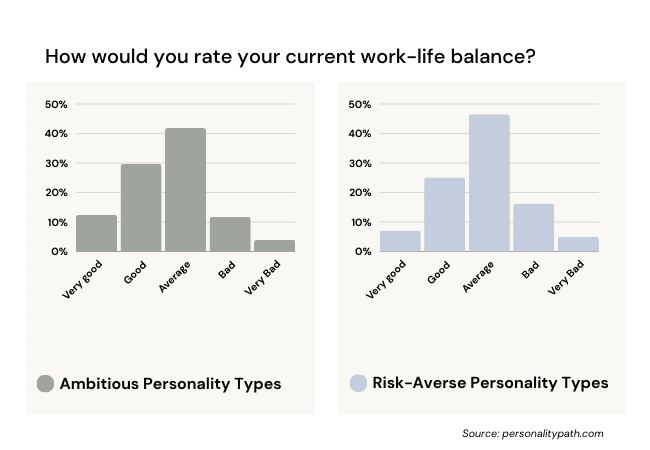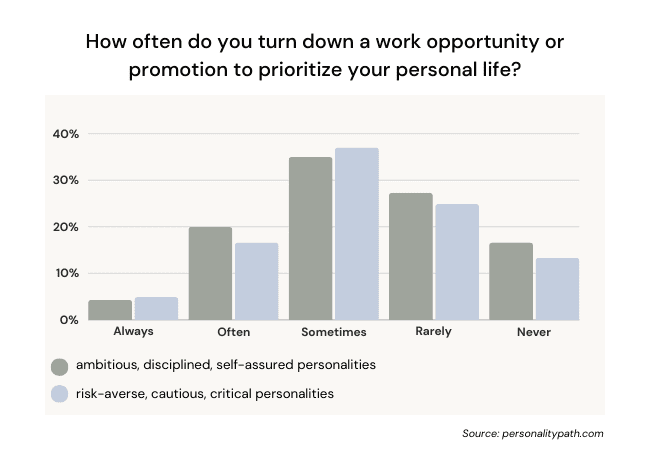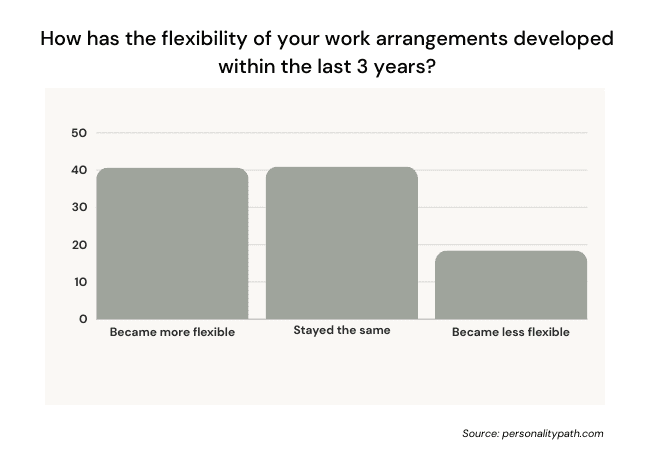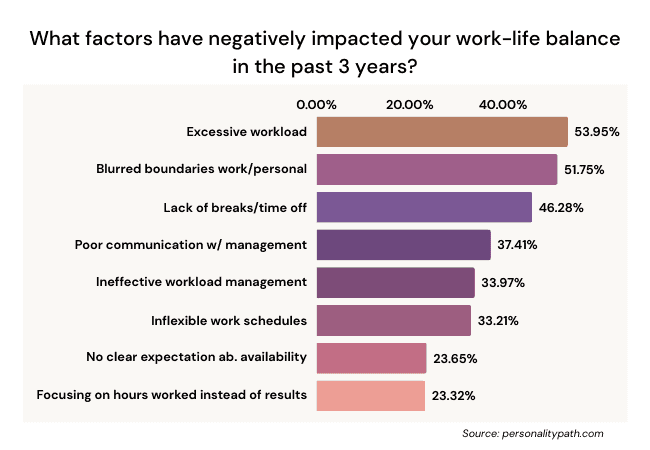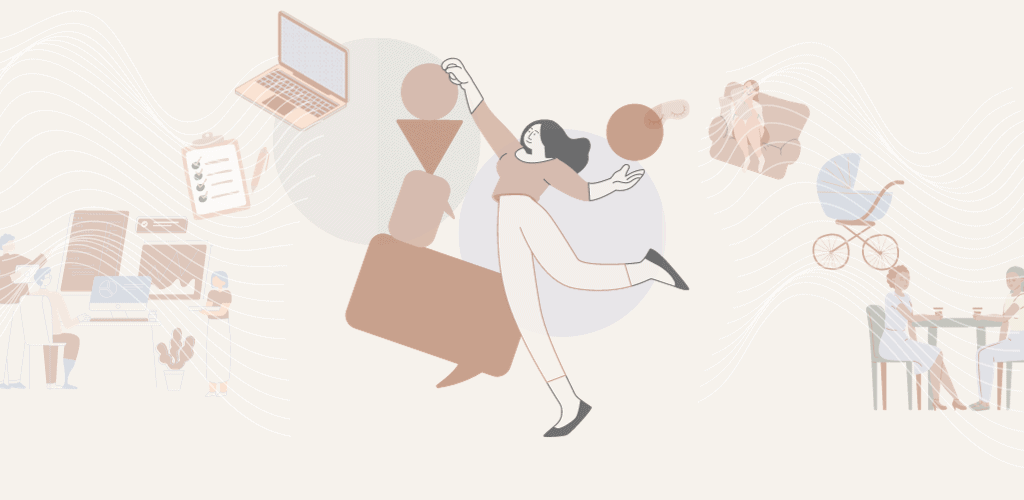
Navigating Work-Life Balance: How Different Personality Types Respond to New Work
What you will learn
In the ever-evolving landscape of the contemporary work environment, the dynamics of professional life have undergone a seismic shift, propelled in no small part by the unprecedented events of the past few years. With the advent of the digital era, compounded by the global pandemic, the traditional notions of work have been redefined, challenging organizations to adapt to new paradigms. And HR professionals need to stay alert to what the workforce needs.
“We believe that looking at different personality types in the workplace, especially in this age of new work, will become more and more important for team leaders, HR professionals – and team health in general.”, says Greg Schneider, founder of Personality Path. “Different people have different needs, and work-life balance looks different for everyone. It was interesting to see the trends within certain personality types brought to light by our survey.”
Key findings
- Work-Life Balance Satisfaction: 30% satisfaction among typically labeled “high achieving” personality types, and personalities that are motivated by career and advancement. In contrast, persons categorized as more cautious, pessimistic, or insecure feel a decrease in work-life balance.
- Many feel challenged by disconnecting from work: Self-assured, optimistic, and more headstrong types can disconnect effectively, while less decisive or secure personality types struggle.
- Pandemic’s Impact on Work-Life Balance: Since 2020, the change in the work environment had a positive impact on self-assured and driven personality types; the changing workforce posed more of a problem for personality types that are generally less self-assured, less optimistic, and less intrinsically motivated by career advancements.
- Flexibility in work arrangements is linked with productivity: Increased flexibility correlates with improved productivity for “high achieving” personality types. Reduced flexibility can be noted for more cautious, pessimistic, or insecure personality types, associated with a decline in productivity.
- Income influences work-life balance: Respondents earning more than $200,000 (roughly 9% of high achieving personality types and self-assured individuals, compared to only 3% of less optimistic and driven personalities) consistently express higher satisfaction levels with work-life balance compared to those earning between $25,000 and $50,000 (20% of more cautious, pessimistic, or insecure personality types).
The Pandemic’s Influence on the Contemporary Work Environment
In the wake of the COVID-19 pandemic, the workforce has experienced a profound transformation, reshaping the very fabric of how and where work takes place. The once firmly established boundaries between professional and personal life have blurred, giving rise to a virtual workspace that transcends traditional office walls.
As we navigate this uncharted territory, the transition to remote work stands out as a defining feature of the contemporary work environment. Remote work has once been a limited practice but has now become an integral component of the professional landscape. Even though this survey did not specifically ask questions about Work from Home and Remote Work, both topics are strongly implied by most questions focusing specifically on the last three years.
This shift brings both challenges and opportunities, prompting companies and their leaders to explore innovative strategies to maintain productivity, engagement, and the delicate balance between professional responsibilities and personal well-being.
For professionals in HR and management, the implications are far-reaching. The mandate to foster a harmonious work-life equilibrium has become more pronounced than ever.
Our study aims to take a closer look at this apparent change, examining the impact on job satisfaction, the challenges of disconnecting in a virtual realm, and the pivotal role of flexibility in work arrangements. Join us as we dissect the contemporary work environment, unraveling the intricacies that shape the experiences of professionals today.
Through this exploration, we aim to provide valuable insights and actionable strategies for HR and management professionals seeking to navigate and optimize the ever-changing dynamics of the modern workplace.
Work-Life Balance in General
Work-life balance is the delicate dance between professional responsibilities and personal well-being, a dynamic interplay crucial in today’s modern workplace. It’s not just about the clock; it’s about fostering an environment where individuals thrive at work and in their personal lives. This equilibrium is the secret sauce for heightened job satisfaction, productivity, and a workforce that excels beyond the confines of the office walls.
Satisfaction with Work-Life Balance
The survey offered us insightful perspectives on the current state of satisfaction among employees regarding their work-life balance. Approximately 30% of respondents from both ambitious and competitive, as well as risk-averse and non-competitive types, express satisfaction with their work-life balance, highlighting a notable sense of harmony in their professional and personal realms.
On the flip side, personality types that tend to be more self-critical, less ambitious, and less flexible collectively indicate a perceived imbalance, with 26.2% of respondents deeming their work-life balance as less than optimal. Delving deeper, our findings reveal a striking contrast between “extroverted” – highly ambitious and decisive types – and introverted – more skeptic, reliant, and less ambitious – types, where 17% of extroverted respondents claim an ‘exceptionally good’ balance, in stark contrast to a mere 4.7% among introverted respondents. The extremes of ‘very good’ and ‘very bad balance’ are represented by highly ambitious types and less ambitious and indecisive types respectively.
“We were surprised to see a personality type we’d consider work-driven, ambitious, and self-confident, in our terminology Type 1, to also emerge as a participant in the ‘very bad balance’ category.”, says Greg Schneider.
Interestingly, this seems to be connected with the fact that those categorized in the Enneagram as Type 1, Type 3, and Type 8 – all personality types that fall in the ambitious, instinctual, and decisive types – reported the highest weekly work hours, with a notable concentration around the 70-hour mark. Conversely, respondents classified as Type 4, Type 6, and Type 9 – classified as non-competitive, disciplined, but reliant types – reported working the least hours, consistently falling below the 20-hour threshold.
Photo by Elisa Ventur on Unsplash
Personal Life vs. Work Life: Challenges of Disconnecting in a Remote Work Environment
The constant connectivity in our current work environment has reshaped work-life balance, offering flexibility but also raising concerns about stress and burnout. While digital connection enhances productivity and collaboration, the blurred boundaries between work and personal life can negatively impact well-being. Striking a balance and managing constant connectivity is essential for a healthier work environment.
We asked people how well they were able to disconnect from work in an increasingly remote environment.
Headstrong and independent personality types stand out as those who can effectively disconnect from work, showcasing a commendable capacity for creating boundaries between professional obligations and personal time.
Contrastingly, skeptic, cautious, and risk-averse types, report struggling to disconnect from work, underscoring the challenges faced by a significant portion of the workforce in maintaining a clear separation between professional and personal spheres.
A noteworthy revelation surfaces in pondering, reliant, and introverted types, coded as Type 4 within the Enneagram, where a distinct 5.8% of respondents express an inability to ever disconnect from work. This statistic starkly contrasts a mere 2% of instinctual, decisive, and impulsive (Enneagram Type 7s) respondents facing a similar challenge. This discrepancy prompts a deeper examination of the factors influencing this disparity. It naturally opens avenues for exploring strategies to enhance the ability to disconnect in a remote work environment.
Prioritization of Personal Life Over Work
Ambitious, instinctual, and spontaneous personality types are notably characterized by their inclination to never turn down work opportunities in favor of prioritizing personal life (18.7%). This suggests a prevailing ethos of dedication to professional responsibilities within this subset of the workforce.
Personality types that show less ambition, are more risk-averse, and withdrawing, showcase a contrasting tendency, consistently choosing to prioritize personal life over work by consistently turning down work opportunities. This inclination underscores a distinctive perspective of valuing personal time and well-being.
The juxtaposition of these responses signifies a spectrum of attitudes towards work-life balance. As we navigate the dynamic landscape that has unfolded since the onset of the pandemic in 2020, these results prompt a closer examination of the factors influencing this shift.
The Pandemic’s Influence on the Work Environment since 2020
General trend in work-life-balance since 2020
This 2023 article on “Working from Home: Before and After the Pandemic” by Hilary Silver, part of the George Washington University’s sociology department, highlights that before the pandemic, around 7.3% of the U.S. labor force primarily worked from home, but by 2021, this figure rose to 17.9%.
Not surprisingly, 10.3% of optimistic, self-assured, and extroverted personality types stand out as those reporting a significant improvement in their work-life balance since 2020 (vs. only 5.8% of reliant, non-competitive, less decisive personalities) . This optimistic trend suggests that a segment of the workforce has managed to find equilibrium and potentially capitalize on newfound flexibility in their professional lives.
Conversely, 6.4% more pessimistic, less competitive, and more reliant personality types indicate a significant decline in work-life balance since 2020, twice as high as their more ambitious counterparts (3.1%). This decline underscores the challenges faced by individuals within these subsets, potentially attributed to shifts in work structures and expectations.
The examination of flexibility in work arrangements since 2020 further enriches our understanding. “High achievers” highlight increased flexibility due to remote work and hybrid models. On the contrary, cautious, non-competitive, self-critical personality types experienced reduced flexibility, reflecting a connection to the reported decline in work-life balance.
As we delve deeper into the implications of these findings, it becomes evident that the pandemic has not only reshaped the professional landscape but has also had a profound impact on individual perceptions of work and life integration.
How Individuals are Affected by an Increase in Flexibility
As work flexibility becomes more common, it’s essential to look at how it affects how happy and productive employees are. Understanding this connection helps companies find the right balance between giving employees flexibility and making sure the work gets done well.
For spontaneous, independent, and headstrong personality types, the consensus points toward an improvement in productivity resulting from the increased flexibility in work arrangements. This positive correlation suggests that, for these subsets of the workforce, adaptability has translated into heightened efficiency and output.
However, risk-averse, introverted, self-critical types indicate a decline in productivity attributed to the same increased flexibility. This intriguing finding prompts a deeper exploration into the factors contributing to this negative impact. It points to potential challenges that may arise in the wake of more flexible work environments.
Photo by Christophe Hautier on Unsplash
Balancing Negative and Positive Factors of Workforce Flexibility
More inclusivity and autonomy
For many, the shift in the workplace has also forcefully brought forward positive aspects that positively impact their work-life balance, such as a culture of trust, and increased autonomy, as well as regular breaks and time off.
Within the realm of work-related aspects, an inclusive work environment emerges as a key contributor for 29.3% of participants, with “high achieving” personality types especially expressing its significance (31.8% vs. 24.7% of less ambitious types). The emphasis on continuous learning and regular breaks is notably beneficial, as reported by methodical, more ambitious, and competitive personalities.
On a personal level, access to childcare or family support proves to be a crucial element for fostering work-life balance. This is particularly highlighted by personality types that are less driven, career-focused, more reliant, and less independent (7.3%). Recognizing the importance of these positive factors across different personality types is instrumental for organizations seeking to cultivate environments that support the well-being of their diverse workforce.
Blurred Lines between Personal and Professional mixed with an Excessive Workload
The survey results on negative factors impacting work-life balance in the last three years highlight a common concern across all personality types: an excessive workload and the blurring of boundaries between work and personal life. This prevailing issue notably affects professionals across outgoing, ambitious, and disciplined personality types (29.3%).
Especially non-competitive, self-critical, and more emotional types (specifically Type 4 in the Enneagram) appear impacted by a focus on hours worked rather than emphasizing results, with 17.1% of respondents within this personality types offering this answer (vs. roughly 12% of other personality types). These insights underscore the challenges stemming from increased workloads, and separating work and personal life. As organizations strive to cultivate healthier work environments, understanding the nuanced impact of various personality types will be crucial in developing targeted strategies to mitigate these negative factors and enhance overall work-life balance.
Other challenges have also come to light, including potential burnout since the start of the pandemic and the shift in the workplace, as this article by the American Psychological Association highlights.
The blurred boundaries between personal life and work have been linked to increased work-related stress. As individuals find it challenging to disconnect from work, this continuous engagement can contribute to heightened stress levels, impacting overall well-being.
Income and Its Connection to Work-Life Balance
In addition to specific questions regarding work-life balance, we inquired about the yearly income of our participants. Our survey data reveals a compelling trend, indicating that respondents with annual incomes ranging from $150,000 to $200,000 (personality types typically labeled “high achievers”) consistently express higher satisfaction levels with their work-life balance compared to those earning between $25,000 and $50,000 (more cautious, pessimistic, or insecure personality types).
On the other hand, it is interesting to note that when asked, two-thirds chose a better work-life balance over better pay, according to Flex Jobs’ 2022 Career Pulse Survey.
Opportunity to Impact the Future of the Workplace
As we look ahead to this new year, it is evident that the traditional work environment must undergo further transformation, with flexibility emerging as a linchpin for the future. Our findings underscore the pivotal role of flexibility in the workforce, a key element for the future. Professionals with self-assured, independent, and highly ambitious personality traits highlight increased productivity with greater flexibility, while there are personality types who tend to be less ambitious, more reliant on structure, and overall more pessimistic, who grapple with a decline.
HR professionals have a unique opportunity to impact and mold work environments. Recognizing the positive factors such as trust, autonomy, and family support, and addressing negative factors like excessive workloads, blurring boundaries, and income disparities, can pave the way for a more balanced, fulfilling work experience.
HR professionals have the unique chance to be architects of change, sculpting workplaces that prioritize individual well-being and satisfaction.
The study’s insights, particularly regarding the correlation between flexibility and productivity, provide a roadmap for organizations to strike the right balance in work arrangements. Embracing this opportunity for adaptation and innovation, HR professionals can play a pivotal role in shaping a future where work is not just a means of livelihood but a source of fulfillment and balance.
5 Strategies Employers can Work with to Support their Teams
- Emphasize Flexibility and Autonomy:
Encourage a culture that values flexibility and autonomy in work arrangements. Allow employees to have control over their schedules and remote work options, recognizing that individuals have diverse needs and responsibilities outside of work. This not only promotes a healthier work-life balance but also empowers employees to manage their tasks in a way that suits their personal and professional lives.
- Prioritize Mental Health and Well-being:
Acknowledge the impact of the evolving work environment on mental health and well-being. Provide resources such as employee assistance programs, mental health days, or counseling services. Foster an open dialogue about mental health, reducing stigma, and promoting a supportive atmosphere. Encouraging breaks, mindfulness practices, and regular check-ins can contribute to a positive and holistic work environment.
- Invest in Skill Development and Learning Opportunities:
Facilitate continuous learning and skill development to help employees adapt to new technologies and work methodologies. Offering training programs and upskilling opportunities enhances employees’ professional growth and boosts their confidence and adaptability in the face of change. This investment demonstrates a commitment to the holistic development of your team members.
- Promote Inclusivity and Diversity:
Foster a workplace culture that embraces diversity and inclusion. Recognize and celebrate differences among team members, creating an environment where everyone feels valued and heard. Implement inclusive policies and practices, ensuring that all employees, regardless of background, feel a sense of belonging. This contributes to a positive work environment and enhances creativity and innovation within the team.
- Establish Clear Communication Channels:
Transparent and effective communication is crucial in navigating the new work environment. Articulate expectations, provide regular updates, and seek feedback from employees. Establish open channels for communication, whether through regular team meetings, feedback sessions, or digital collaboration platforms. Clarity and transparency contribute to a sense of security and trust among team members, fostering a cohesive and resilient work environment.
You may also find our article on how personality types can help you build trust in your teams useful.
By implementing these tips, employers can create a supportive and adaptive work environment that addresses the holistic needs of their employees. This approach not only enhances job satisfaction but also cultivates a resilient and engaged workforce capable of navigating the challenges of the evolving professional landscape.
If you’re interested in the study framework and detailed results: You can find a more detailed overview of the study specifics here.
If you’re working as an HR professional, or work with teams to foster understanding and collaboration, we’d love to hear your expert opinion. Reach out to us at [email protected].


